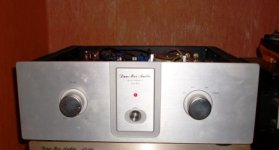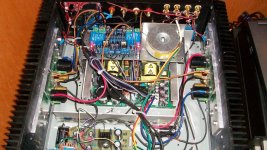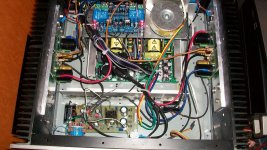Hi Theo
SMD 1206 thick film 47 ohm 1% are 0,5 W
SMD 1206 metal film 47 ohm 1% are 0,25 W
Regarding dissipation both are OK, only that metal film are more recommended for audio.
Farnell 47 ohm 1206
Regards, L.C.
SMD 1206 thick film 47 ohm 1% are 0,5 W
SMD 1206 metal film 47 ohm 1% are 0,25 W
Regarding dissipation both are OK, only that metal film are more recommended for audio.
Farnell 47 ohm 1206
Regards, L.C.
Hi All. Is this normal that my left channel runs 3 degrees cooler than right one.
44 vs 47 C
Nothing to worry about?
Hi
Measuring +rail supply current of each channel would explain this. Please check and report.

LC , thanks I advance for the support. I think that I will look again after the measurement of the rail at the right and left channel. Maybe I put somewhere after the 1.3 mod too little thermal paste on it. I have put there the better GELID*Solutions GC-Extreme*Thermal Compound. After the gain measurement I wil check this. And disassemble the channel and put more thermal paste on it.
Operating conditions settings
To measure the whole DC supply quiescent current of the First One channel, one would need digital voltmeter and 1 ohm/2 W resistor.
The easiest and safest way would be to connect 1 ohm/2 W resistor in series to positive supply wire, meaning in practice this resistor would be connected between power supply's positive output and channel's positive DC input. Powered on First One channel entirely consumes 280 mA through each supply wire so the voltage drop on 1 ohm serial resistor would be exactly 0,28 V measured by voltmeter on resistor's leads. If not, adjust trimmer TR3 accordingly to get desired 280 mA quiescent supply current.
At this stage also check output DC offset voltage, measured on amplifier's output terminals (between +OUT and GND), reading should show +/-5 mV. If not, adjust trimmers TR1, TR2 accordingly to get desired 0 mV +/-5 mV output DC offset voltage.
Correctly adjusted values sets the First One amplifier to optimal operating conditions.
L.C.
Hi LC. How to measure that? I'm newbie in this area, that's why you assembled my AMP 😄 if you say what pin on the pcb I will do so . Or some photo instructions 😄
To measure the whole DC supply quiescent current of the First One channel, one would need digital voltmeter and 1 ohm/2 W resistor.
The easiest and safest way would be to connect 1 ohm/2 W resistor in series to positive supply wire, meaning in practice this resistor would be connected between power supply's positive output and channel's positive DC input. Powered on First One channel entirely consumes 280 mA through each supply wire so the voltage drop on 1 ohm serial resistor would be exactly 0,28 V measured by voltmeter on resistor's leads. If not, adjust trimmer TR3 accordingly to get desired 280 mA quiescent supply current.
At this stage also check output DC offset voltage, measured on amplifier's output terminals (between +OUT and GND), reading should show +/-5 mV. If not, adjust trimmers TR1, TR2 accordingly to get desired 0 mV +/-5 mV output DC offset voltage.
Correctly adjusted values sets the First One amplifier to optimal operating conditions.
L.C.

Version 1.2
Hello
My interpretation of a FO Version 1.2 amplifier. the
Preamplifier is realized with LME 49710. Preamplifier and relay Input selector have a separate power supply. On reaching 75 degrees heat sink temperature, the power is turned off.
Best regards Gerd
Hello
My interpretation of a FO Version 1.2 amplifier. the
Preamplifier is realized with LME 49710. Preamplifier and relay Input selector have a separate power supply. On reaching 75 degrees heat sink temperature, the power is turned off.
Best regards Gerd
Attachments
Impressions 1.2 vs 1.3
I have updated my amplifier to version 1.3. My Impressions:
Both versions are at a very high level. A Controlled, dry bass have both versions. Version 1.3 sounds a bit more reserved and gentle in the heights. It sounds sweet and relaxed. A very pleasant sound. Version 1.2 sounds analytically and has a high resolution, without sounding cold. It is a matter of taste. Surely it also depends on the speakers and the music direction. I for example do not like the warm sound of tube amplifiers. I like dynamics, resolution and deep controlled bass. That's why I prefer version 1.2. Both versions are great amplifier and find their lovers. Congratulations to LC.
Best regards Gerd
I have updated my amplifier to version 1.3. My Impressions:
Both versions are at a very high level. A Controlled, dry bass have both versions. Version 1.3 sounds a bit more reserved and gentle in the heights. It sounds sweet and relaxed. A very pleasant sound. Version 1.2 sounds analytically and has a high resolution, without sounding cold. It is a matter of taste. Surely it also depends on the speakers and the music direction. I for example do not like the warm sound of tube amplifiers. I like dynamics, resolution and deep controlled bass. That's why I prefer version 1.2. Both versions are great amplifier and find their lovers. Congratulations to LC.
Best regards Gerd
Hi Gerd
Impressive integrated amp of yours, congratulations.
You're the first to implement v1.3 upgrade, cool, my admiration to that too.
Generally I agree with your findings although I know v1.3 has higher resolution, much more fine details and greater 3D imaging, recreating soundstage more accurately, whatever that could be.
Trying not to impose too much to forthcoming opinions, nevertheless maybe after some more listenings you'll get similar impressions too, tantalum needs to form too.
Regards, L.C.
Impressive integrated amp of yours, congratulations.

You're the first to implement v1.3 upgrade, cool, my admiration to that too.

Generally I agree with your findings although I know v1.3 has higher resolution, much more fine details and greater 3D imaging, recreating soundstage more accurately, whatever that could be.
Trying not to impose too much to forthcoming opinions, nevertheless maybe after some more listenings you'll get similar impressions too, tantalum needs to form too.
Regards, L.C.

Maybe it's time i share my view too. I have been a fan of the franchise since early VSSA days. My tube pre had to undergo substantial remodeling to suit, but i have no regrets for the effort.
As it is all about the sound, this is how i see it
Good
- detail resolution is amazing
- soundstage and background detail
- absence of subjective distortion
- dynamically excellent and keeping all together even at high volumes
Not so good
- insufficiently fleshed out mids
- poor PRAT
- weak mid-bass punch
As always, there is no complete happiness.
The 1.3 mod, at least to my ears was very subtle and only improved areas where the amp already excelled.
As i have always been more than a bit skeptical about smd parts, i used to occasion to (briefly) replace the series nfb resistors with 5W Mills and the shunt with some standard metal films. Soundwise this didn't work well at all.
So, there you have it - a great amp became very slightly better.
PS It is probably worth mentioning that both of my FO amps do not use the recommended PS, which may account for my conclusions. One has a pair of 600VA EI trafos feeding 2 x 47000uF per channel of FELSIC caps, while the other has a dual secondary ex-Rotel toroid feeding 4 x 22000uF RIFA PEH169 per channel.
As it is all about the sound, this is how i see it
Good
- detail resolution is amazing
- soundstage and background detail
- absence of subjective distortion
- dynamically excellent and keeping all together even at high volumes
Not so good
- insufficiently fleshed out mids
- poor PRAT
- weak mid-bass punch
As always, there is no complete happiness.
The 1.3 mod, at least to my ears was very subtle and only improved areas where the amp already excelled.
As i have always been more than a bit skeptical about smd parts, i used to occasion to (briefly) replace the series nfb resistors with 5W Mills and the shunt with some standard metal films. Soundwise this didn't work well at all.
So, there you have it - a great amp became very slightly better.
PS It is probably worth mentioning that both of my FO amps do not use the recommended PS, which may account for my conclusions. One has a pair of 600VA EI trafos feeding 2 x 47000uF per channel of FELSIC caps, while the other has a dual secondary ex-Rotel toroid feeding 4 x 22000uF RIFA PEH169 per channel.
- Home
- Vendor's Bazaar
- First One - mosFET amplifier module




